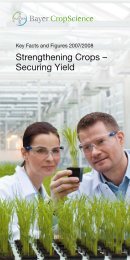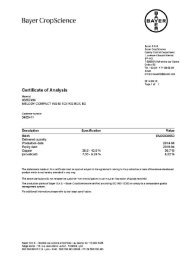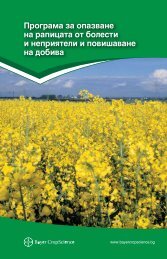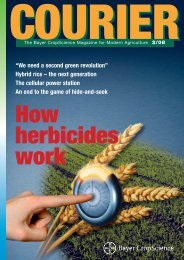Potatoes⦠- Bayer CropScience
Potatoes⦠- Bayer CropScience
Potatoes⦠- Bayer CropScience
Create successful ePaper yourself
Turn your PDF publications into a flip-book with our unique Google optimized e-Paper software.
Compostable plates and saucers<br />
Toys (Photos: Kompetenzzentrum für Nachwachsende Rohstoffe,<br />
KoWaRo, Germany)<br />
than 100,000 tonnes a year; however, the<br />
European Bioplastics Association forecasts<br />
a rapid increase in capacity, with<br />
world-wide production exceeding 1.5 million<br />
tonnes by 2011, not least because of<br />
high oil prices and the question of climate<br />
change. In countries such as France, Italy<br />
and Australia, there is a political will to<br />
introduce biologically-degradable carrier<br />
bags. Experts predict that with today’s<br />
technologies, biomaterials would be able<br />
to replace 1 to 2 million tonnes-worth of<br />
mineral oil-derived disposable plastics, so<br />
long as worldwide production capacity<br />
increases correspondingly. This will of<br />
course mean greater demand for potato<br />
starch.<br />
But the industrial application of starches<br />
from spuds is certainly not limited to<br />
these uses. Potato starches are also used to<br />
produce bio-surfactants that can replace<br />
synthetic detergents in washing powders,<br />
soaps and shampoos. And let’s not forget<br />
that potato starch can be fermented and<br />
distilled into bioethanol, which is being<br />
mixed with conventional petrol in a number<br />
of industrial countries. It is even economically<br />
worthwhile to produce biofuels<br />
from the peelings that are a by-product<br />
of the food industry. According to the<br />
German (Bavarian) raw materials network<br />
C.A.R.M.E.N., the long-term trend in the<br />
use of starches lies in chemical and technical<br />
applications.<br />
In the future, biotechnology may improve<br />
the efficiency with which renewable<br />
raw materials are obtained from potatoes,<br />
because gene technology can be used to<br />
alter a variety’s starch profile. But Agrobiotechnology<br />
will also help to protect the<br />
potato plant from the numerous pests and<br />
diseases that attack it. Given the growing<br />
world population, this is an important task<br />
– a hectare of potatoes not only has the<br />
potential to produce the highest starch<br />
yield for industrial uses; it could also be<br />
used to produce food with two- to fourtimes<br />
the nutritional yield of wheat, and<br />
a higher nutritional contribution per unit<br />
of water used than any other major crop<br />
plant. ■<br />
Written by: Norbert Lehmann<br />
Did you know that the potato…<br />
• was probably first cultivated more than 8,000 years ago, in the<br />
Andean highlands near Lake Titicaca<br />
• is grown today in more than 125 countries around the globe<br />
• is related to aubergine, tomato and tobacco, but not to sweet potato<br />
• is available in over 5.000 cultivars from more than 100 wild-types<br />
• provided – with its tiny starch grains – the basis for the Lumière<br />
brothers’ 1903 patent for a colour photography technique<br />
• comprises up to 80 % water<br />
• was the first vegetable to grow in space (onboard the Space Shuttle<br />
Columbia, in 1995)<br />
• is rich in vitamin C and essential minerals such as manganese,<br />
selenium and molybdenum<br />
• doesn’t absorb salt during cooking<br />
1/08 COURIER 31















